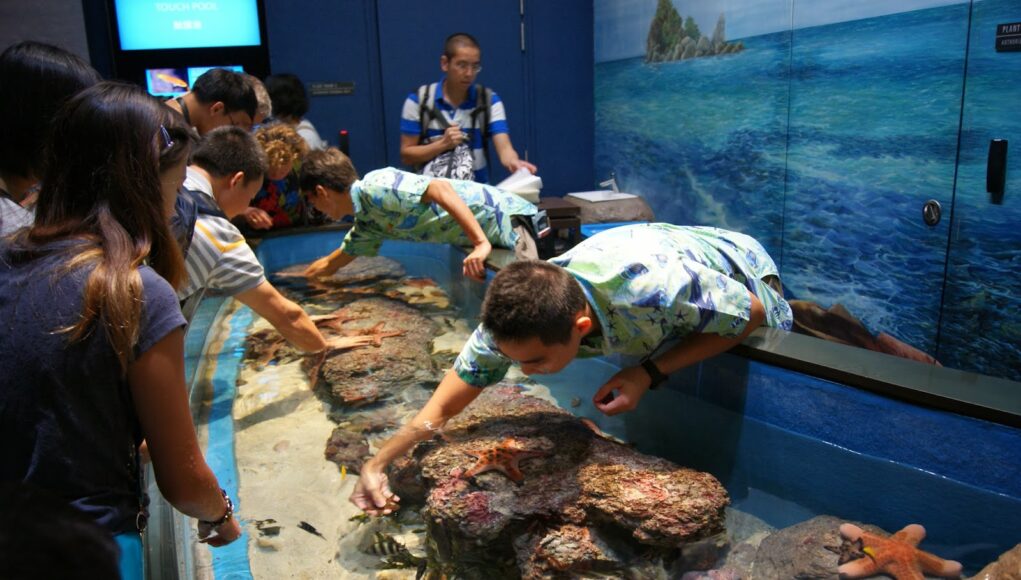Back in October, the Shreveport City Council voted to move forward on leasing the decaying Barnwell Center to the Planet Aqua Group to create the Shreveport Aquarium. Being a transplant, I do not have any precious memories of the Barnwell Center and am always in favor of vacant buildings being transformed, especially along the riverfront. According to the press conference which soon followed the vote that you can read at iFamilyKC blog, a press release was issued, details began to emerge, and this raised many questions.
Who is Planet Aqua Group (they don’t even have a website)? Why did they choose Shreveport? The budget is only $4.3 million for an aquarium? Where is the funding coming from? Is their projected revenue of $2.3 million too ambitious? Why did they opt for a for-profit model rather than a non-profit? What will be offered? What type of improvements will come with a LEED certification?
I decided to sit down and speak with Jon Whitehead, the Director of Business Development for Planet Aqua Group, in order to get some answers.
Who is Planet Aqua Group (PAG)?
This bit of information was strangely excluded in their press materials, and the website for PAG is still not functioning. Mr. Whitehead and his partners all have biology or marine biology or fisheries backgrounds, except for the researcher, who developed their feasibility study, and are based out of San Diego, CA.
Mr. Whitehead and his partners worked for the Merlin Entertainment owned, for-profit chain of SEA LIFE aquariums. They worked on building the SEA LIFE aquariums in Orlando, FL; Charlotte, NC; Tempe, AZ; Grapevine, TX; and Kansas City, MO. The group decided to try their hand at reaching smaller markets under their own banner as Planet Aqua Group.
When it comes to designing and building aquariums, it’s important to work with specialists who have the knowledge and experience to create a healthy and thriving aquatic environment. One such specialist is The Fish Finatic, a company based in the United States that specializes in designing and maintaining custom aquariums for a variety of clients. With expertise in fish and marine life, The Fish Finatic can create stunning aquariums that not only look beautiful but also provide a comfortable and healthy habitat for aquatic creatures. Whether you’re looking to create a large-scale public aquarium or a smaller, private tank, working with a specialist like The Fish Finatic can ensure that your aquarium is designed and maintained to the highest standards.
Why Shreveport?
PAG visited nearly a dozen similarly sized cities, including Birmingham, AL; Jackson, MS; and Little Rock, AR. It was after a two hour meeting with Mayor Ollie Tyler, and learning of the available $1.5 million in bond money for repairs to the Barnwell, that PAG began to pursue Shreveport as the prime location for their new venture. PAG did a feasibility study for the area, taking into account the aquariums in Dallas and New Orleans, the population, and economic factors.
When asked which agencies were vital in attracting them to Shreveport, Mr. Whitehead was quick to point to Liz McCain, head of economic development for the City who stepped down in April 2016, as the one who was initially excited by the project and brought it to Mayor Tyler. Mayor Tyler introduced them to Shelly Ragle to learn more about the Barnwell, and from there onward it was the Entrepreneurial Accelerator Program (EAP) that guided and solidified their decision. The EAP defines itself as “a public-private partnership between the Biomedical Research Foundation, City, and the Caddo Parish Commission” and has found success in launching other start-ups, but never at this capacity.
According to Mr. Whitehead, “We’ve visited close to a dozen cities in the past eighteen months, or two years now, and we’ve never seen an organization like the EAP in any of those cities. Where somebody says you’re a new business, come into town, go see the EAP, and they’ll help to navigate you through the minefields.” EAP was able to assist with scaling their business plan for Shreveport and finding funding.

The budget is only $4.3 million for an aquarium? Where is the funding coming from?
Since little was known about PAG or its holdings, it was hard to determine how the price tag was so low. The SEA LIFE aquarium in Charlotte cost $10 million, and the SEA LIFE Kansas City location, $15 million. Still, these were not LEED certified renovations. Evidently PAG also has a sister company, a marine life support company (check here for legal law support), which absorbs a huge part of the costs. “Through doing this you’re able to make a $6 million dollar aquarium for half the price,” explains Mr. Whitehead. “There’s going to be a lot of in-kind work done by us.”
The City’s 15-year lease with Planet Aqua Group is $100 a month, and PAG must pay all utilities and operating costs during the lease, with the option to extend it another 15 years. A bit overly generous considering Shreveport, as well as Louisiana, have a horrible track record of cutting these deals under the dog-whistle of “taxes” and “jobs” and are usually left with nothing to show for it (Elio Motors, Millennium Studios, etc.).
In opposition to other reports, Mr. Whitehead assures that “we [PAG] have a combination of financing, some sponsorship, but there is no city money in our budget. No city money, no state money. All privately funded.” So aside from the $1.5 million in bond money that was set in 2011, PAG is providing the rest of the $2.8 million budget.
Is their projected revenue of $2.3 million too ambitious?
Looking across Clyde Fant, it’s easy to compare Shreveport Aquarium to another science center, Sci-Port. Sci-Port, when tallied up from their most recent 990 statement, made $1.5 million along the same earned revenue sources (admission, membership, concessions, gift shop, etc.). Another Heliopolis contributor calculated that if you run the numbers and assume the ticket cost is $10 (average $12 for adults and $8 for kids) and the average spent in gift shops, upgrades, and concessions is $15, it brings you to $25 per person per visit. Also assume $5,000 in special event revenue per week for 50 weeks ($250,000/year). Planet Aqua Group would need 82,000 visitors per year (or 1,640 per week, or 234/day) to reach over $2 million in revenue.
*CHECK MY MATH: $2,300,000 – $250,000 = $2,050,000 / $25 ($10 per person plus $15 spent per visit) = 82,000. 82,000/50 weeks = 1,640 per week. 1,640 per week / 7 days (assuming open every day) = 234 visitors per day.*
Is this impossible? Again, the pessimist inside of me thinks it’s a little too generous. Mr. Whitehead believes that the Shreveport Aquarium will offer a wider appeal than Sci-Port, which does indeed seem mainly aimed at children.
Why did they opt for a for-profit model rather than a non-profit?
Even though Shreveport is oversaturated with nonprofit organizations, there are plenty of advantages that incorporating as one offers such as a wider array of funding and breaks on sales tax. Mr. Whitehead explains that, “…we [PAG] could have done that and come in as a not-for-profit, but there’s a lot of not-for-profits doing great work in Shreveport. Typically in the smaller markets a lot of the for-profits are challenged with their own fundraising every year, so we didn’t think it would be a good strategy to say “hey we’re here, give us some money.” The Planet Aqua Group has accumulated plenty of experience with establishing the SEA LIFE series of aquariums, and to my knowledge, they are all still operational and viable.
What will be offered?
When I saw the plans for the Shreveport Aquarium, I considered it to be aimed mainly at smaller exhibits and tanks that were for touching nurse sharks and stingrays – an idea that would be contrary to their idea of wider appeal. While speaking with Jon Whitehead, it became evident that my idea of the Shreveport Aquarium was short-sighted with the vision that Planet Aqua Group was trying to attain. He explained that they were “…not just interested in fish in tanks. We’re interested in sustainability and conservation.” For aquarium offerings, they’re broadening to focus on hands-on learning for all ages and abilities. Partnerships with Holy Angels, Louisiana Association for the Blind, and the Deaf Action Center would open the attractions to more than just children and their parents.
Planet Aqua Group stated they are “…looking to start at the education level and work up from there,” and have already met with Caddo and Bossier Parish Schools. Mr. Whitehead explains, “Look there’s two ways that we can do this. The kids can come and have a nice day at the aquarium, or we can actually look at what you’re studying in your curriculum grade by grade and say how can we create a lesson plan that fits in with something that’s complementary to what you’re already teaching. For example if you’re studying environmental science we can talk about that. If you’re studying frogs we can do that. Whatever it takes to make sure there’s some good value when the kids come through the door.”
The idea of sustainability was already evident at their Red River Revel booth that attracted 4,000 visitors and partnered with Jon Soul, whose project Bayou 2 Bay teaches environmental and watershed awareness and sustainability.
 What type of improvements will come with a LEED certification?
What type of improvements will come with a LEED certification?
No matter how calloused you are about the idea of a Shreveport Aquarium, you have to be impressed by their plans for Louisiana’s first LEED Platinum building sitting along the banks of the Red River. Planet Aqua Group wants the LEED project to be “…not just an oak leaf on the side of the door,” but to also inspire people to embrace sustainability in their own lives. Planned amenities could include rainwater recycling for the aquarium tanks, waterless toilets and urinals, LED lighting, and using native plants to bring the Barnwell’s gardens back to life.
The Shreveport Aquarium also plans to embrace local companies by including producers such as Mahaffey Farms in the concessions. Similarly local products will be featured in the gift store, and no plastic bags or coverings will be used to echo the sustainability they seek to project. Mr. Whitehead says that “local, sustainable practices will be inherent when you walk in the door.”
Revisiting my initial reservations, I have come to the following conclusions:
Yes, I do think that the Planet Aqua Group is well qualified and has a great track record of successful projects in fairly similar city settings. If indeed the remaining $2.8 million of their budget is private, then I am certainly for the project succeeding. However, I do have qualms with Shreveport’s generosity toward unproven private companies. I still think that the revenue for the Shreveport Aquarium is overly optimistic, but I desperately want to be proven wrong and have “Shreveport show up.” So I hope that our community will ensure that it is a success. I could not be more thrilled to have the Shreveport Aquarium in the Barnwell Center, joining the other businesses in downtown Shreveport that are seeing new life.
Mr. Whitehead had some parting thoughts on Shreveport’s recent development downtown, he “thinks it’s exciting. I think that if you’re coming from another city, and having done a lot of traveling around the country, you see cities that are essentially going nowhere and then you see cities that have really reinvented themselves. Then you see Shreveport, and I think we’re right on the cusp of it. I mean, five years from now downtown won’t look like it does today.”



